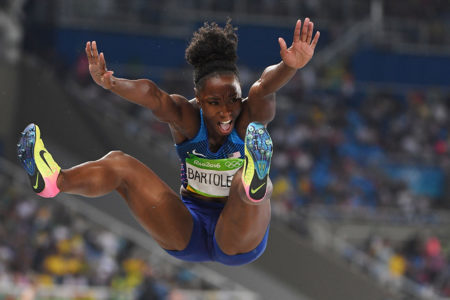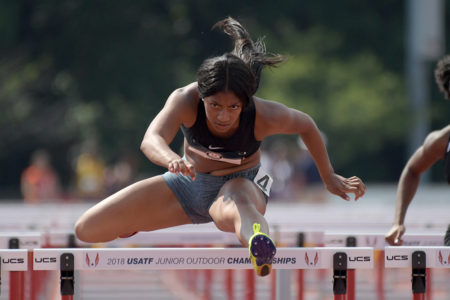Here’s this month’s collection of generally off-track activities that have gone a long way towards shaping the way the sport is headed:

The IAAF Announces New-Nation Transfers
Back in the August issue this space noted the new conditions under which the IAAF would allow athletes to claim allegiance to a different flag. The international body has now released the names of 8 athletes who have successfully met the criteria. Prime among them is Rai Benjamin, USC’s Collegiate-Record setting 400 hurdler, who moved over from Antigua. Benjamin’s posting of the news on Twitter caused Florida superstar Grant Holloway to respond, “Can I run on a 4×4 w/ you?”
The other new American in the group is 35-year-old steeplechaser Haron Lagat, originally from Kenya. They’re both U.S.-eligible now, but perhaps the biggest name in the group, former Cuban triple jumper Pedro Pablo Pichardo, won’t be eligible to represent Portugal until August 1 of next year. IAAF head Seb Coe said, “I’m pleased to see the new system is now working as we intended, allowing athletes with a genuine connection to a new country to represent that country after appropriate checks and balances.”
Surgery For Rupp
A spring marathon is not in the cards for America’s top male marathoner. Post-Chicago, Galen Rupp had surgery on his left foot that will knock him out of action until at least next summer. The October surgery corrected Rupp’s problems with Haglund’s Deformity, a bony heel bump that irritates the Achilles tendon.
According to Ken Goe of oregonlive.com, Rupp has the bump—believed to be congenital—on both heels, though the left one is the only one that has needed fixing so far. Though the malady caused Rupp some issues in his fall buildup—he had to withdraw from the Copenhagen Half-Marathon because of Achilles trouble—in Chicago he was able to finish 5th in 2:06:21. “I was hoping and praying it would hold up. And, really, it did,” said Rupp. The next day, however, the swelling made it difficult to walk. That led to surgery 12 days later.
Surgeon Dr. Amol Saxena told Goe that Rupp’s Achilles had partially torn in two places, noting, “He’s pretty amazing. I’ve treated almost 100 Olympians. He definitely has the highest pain threshold of anybody I’ve treated.” Had Rupp put off the surgery, he continued, the Achilles could have torn completely.
What Next For Farah?
The dominant long-distance track performer of the last decade keeps us guessing on where his career might take him next. Before his Chicago Marathon win, Mo Farah addressed the topic of an Olympic 26-miler, saying, “I am definitely going. As long as my body can hold up, I am definitely going to Tokyo. I know from my training that I am definitely capable of getting a medal. I don’t know what the color is going to be, but I want to continue through 2020. A medal would definitely rank up there in terms of being a track runner and being able to do something in the marathon. In my mind, it’s something I’ve always thought I could do.”
After Farah’s win in Chicago, coach Gary Lough hinted that his charge’s track career might not be over quite yet. “He really wants to run the World Championships but what he runs at the World Championships hasn’t been decided,” Lough told Ben Bloom of the London Telegraph. When asked to clarify those plans, Lough said, “We have to look at a few more things and get things tied down. He might change things up a bit next year, surprise a few people so we will see.”
Coe Asks Senegal To Extradite Diack Fils
In this space last month we noted that French authorities had added breach of trust charges against Lamine Diack for using his position as the IAAF’s head to allow his son, Papa Massata Diack, to skim money from various federation sponsors. The younger Diack has spent the last several years on Interpol’s most-wanted list while living in Senegal, which says it will not deport him to France.
Nonetheless, the IOC has awarded the 2022 edition of the Youth Olympic Games to Senegal’s capital, Dakar. Current IAAF head Seb Coe used the occasion to talk to the Senegalese president about the situation. “I took the opportunity to request his assistance in working with the French prosecution to bring to a close an unhappy chapter in our sport,” Coe told insidethegames.biz. “To date Senegal is the only country that has refused to engage with the investigation and we would like to see this change as the country prepares to stage an Olympic event. The President agreed to discuss this and the President of the Senegal Olympic Committee has said he will visit Monaco later this year.”
Queried by reporters on the subject, IOC head Thomas Bach said, “We have been in contact with Seb Coe on this. We have asked Senegal already a long time ago to assist in the inquiry and we have had assurances months ago that if the French authorities want to hear Papa Massata Diack then they can come to Senegal and there he will be at the disposal of the French authorities.”
Doha’s Cool Stadium
As the calendar page turned to September 27, marking a year to go before next year’s World Championships, Doha turned on the outdoor air conditioning in Khalifa International Stadium and opened its gates to invited guests and media. The reviews were positive.
As a press release for the occasion noted, “Track temperatures were set to a pleasant 24-26 degrees Celsius [c77F] courtesy of the revolutionary in-stadium air-conditioning technology, which will guarantee optimal conditions for athletes and fans alike while also being sustainable.” IAAF Council member Geoff Gardner, leader of a visiting group of team leaders and coaches from 30 countries told The Stadium Business, “I don’t know if the rest of the world really believed this was possible but it’s an amazing system and it shows that our championships can be conducted here in a good environment for the athletes.
Among those in attendance was Aretha Thurmond, USATF’s Managing Director of International & Championship Teams. Thurmond also liked what she saw as she reconnoitered on behalf of Team USA. “For us in the US, heat is nothing new, it is not for us to be afraid of,” said Thurmond, a 2-time discus Olympian and 5-time World Champs competitor. “I think the IAAF and LOC have put a lot of plans in place to obviously make sure that the athletes are safe and make sure they can perform under optimal conditions.
“To me it’s exciting. For them to take the marathon and put it in optimal conditions and do something you need and do a midnight marathon; we have checked on the road course. I think the Corniche [Doha’s bayside promenade where the road races will be held] is gorgeous, it is a great pavement. I know our athletes will be excited to run on such a nice course, flat course; it should be a fast course they always appreciate.”
The Bahamas Hands The Baton To Japan
July brought the news that the host for the first three editions of the IAAF’s World Relays, the Bahamas, was being forced to give up the ’19 staging of the meet. Monaco says that “several member federations contacted the IAAF directly” about stepping in. The IAAF decided on Japan’s second-largest city, Yokohama, which will stage the meet on May 11–12.
Said IAAF head Seb Coe, “Japanese crowds are renowned for their enthusiastic support and I am sure they will give our athletes a tremendous reception next year. This will also be a great opportunity for our athletes to experience the culture and conditions of the host nation little more than a year before the Tokyo 2020 Olympic Games. Yokohama has long been regarded as the gateway to Japan, as the first port opened to foreign trade in 1859, and now it will once again welcome the world.”
New Testo Rule Put On Hold
In exchange for an expedited hearing by CAS, the IAAF has agreed to a stay until March on implementing its new testosterone rule. The new stricture—which limits testosterone amounts for women in the 400 through the mile—had been set to kick in November 1, but has been challenged by Caster Semenya and the South African federation.
Pointing out that a contested stay might drag the legal dispute far into 2019, IAAF head Seb Coe said, “Prolonging the uncertainty for athletes looking to compete in these distances next year and beyond is unfair and so we have reached a compromise with the claimants. We have agreed not to enforce the regulations against any athlete until the contested regulations are upheld. In exchange, they have agreed not to prolong the process. All athletes need this situation resolved as soon as possible.”
The rule will require athletes with “differences of sex development” (DSD) to maintain their serum testosterone levels below a certain level for 6 months prior to competition. The IAAF’s Health & Science Department director, Stéphane Bermon, has advised DSD athletes who wish to begin the 6-month “suppression period” right away to contact the IAAF, so that if the rule goes into effect in March, they can compete promptly. Any affected athlete who waits to see the CAS decision could end up being ineligible until late September of ’19.
Meanwhile, Semenya continues to gain more support in the athletics world and beyond. Nike has recently released an advertising campaign set around her, and Discovery, a major financial services company, has named her its ambassador. “I don’t plan to stop running any time soon,” says Semenya. “I feel like I can keep going until I am at least 40.”
Just How Does One Qualify For Doha?
In the Last Lap section of the November ’17 edition we noted that the IAAF would be implementing a new methodology for athletes to qualify for WC/OG competition, starting with Doha ’19. The announcement at that time had Monaco promising delivery of details in “the first quarter of 2018.” Almost all the details were announced at the end of September.
Crucially missing—even though the IAAF’s new world rankings are the prime component—are the qualifying standards for ’19. Those are now due to be revealed just a few days too late—on November 1—for inclusion in this edition. We’ll have full details on the whole setup in the November T&FN.
NACAC Opposed To New IAAF Qualifying System
Not everybody is happy with the way the IAAF plans on filling fields for the ’19 WC and ’20 OG. Color NACAC (North American, Central American & Caribbean) prime among the dissidents. In early October the NACAC Council addressed the proposed new system in strong words:
“Understanding the system in the athletics community is limited, and on critical points, there are widely disparate views about fairness and viability of the system. Beyond the comments on many specific variables and factors, acute concern was expressed about the lack of genuine consultation with key stakeholders and limited communication.
“The over-arching issue in light of the above is the IAAF’s declared intent to use the ranking system as currently constituted for qualification for the 2019 World Championships and the 2020 Olympic Games. NACAC Council therefore unanimously agreed to inform the IAAF that its view is that the ranking the system should not be used for qualification purposes in 2019 and 2020, and rather that the system should be employed strictly on a pilot basis and that it be the subject of further consultation and refinement prior to introduction as a qualifying system post-Tokyo 2020.” □






